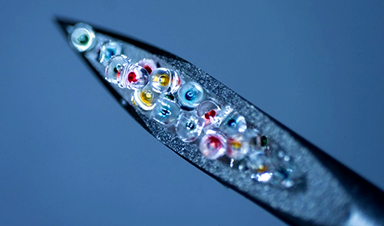| Missing crucial doses of medicines and vaccines could become a thing of the past thanks to Rice University bioengineers’ next-level technology for making time-released drugs. | |
| “This is a huge problem in the treatment of chronic disease,” said Kevin McHugh, corresponding author of a study about the technology published online in Advanced Materials (“A Scalable Platform for Fabricating Biodegradable Microparticles with Pulsatile Drug Release”). “It’s estimated that 50% of people don’t take their medications correctly. With this, you’d give them one shot, and they’d be all set for the next couple of months.” | |
| When patients fail to take prescription medicine or take it incorrectly, the costs can be staggering. The annual toll in the United States alone has been estimated at more than 100,000 deaths, up to 25% of hospitalizations and more than $100 billion in healthcare costs. | |
| Encapsulating medicine in microparticles that dissolve and release drugs over time isn’t a new idea. But McHugh and graduate student Tyler Graf used 21st-century methods to develop next-level encapsulation technology that is far more versatile than its forerunners. |
| Dubbed PULSED (short for Particles Uniformly Liquified and Sealed to Encapsulate Drugs), the technology employs high-resolution 3D printing and soft lithography to produce arrays of more than 300 nontoxic, biodegradable cylinders that are small enough to be injected with standard hypodermic needles. | |
| The cylinders are made of a polymer called PLGA that’s widely used in clinical medical treatment. McHugh and Graf demonstrated four methods of loading the microcylinders with drugs, and showed they could tweak the PLGA recipe to vary how quickly the particles dissolved and released the drugs — from as little as 10 days to almost five weeks. They also developed a fast and easy method for sealing the cylinders, a critical step to demonstrate the technology is both scalable and capable of addressing a major hurdle in time-release drug delivery. | |
| “The thing we’re trying to overcome is ‘first-order release,’” McHugh said, referring to the uneven dosing that’s characteristic with current methods of drug encapsulation. “The common pattern is for a lot of the drug to be released early, on day one. And then on day 10, you might get 10 times less than you got on day one. | |
| “If there’s a huge therapeutic window, then releasing 10 times less on day 10 might still be OK, but that’s rarely the case,” McHugh said. “Most of the time it’s really problematic, either because the day-one dose brings you close to toxicity or because getting 10 times less — or even four or five times less — at later time points isn’t enough to be effective.” | |
| In many cases, it would be ideal for patients to have the same amount of a drug in their systems throughout treatment. McHugh said PULSED can be tailored for that kind of release profile, and it also could be used in other ways. | |
| “Our motivation for this particular project actually came from the vaccine space,” he said. “In vaccination, you often need multiple doses spread out over the course of months. That’s really difficult to do in low- and middle-income countries because of health care accessibility issues. The idea was, ‘What if we made particles that exhibit pulsatile release?’ And we hypothesized that this core-shell structure — where you’d have the vaccine in a pocket inside a biodegradable polymer shell — could both produce that kind of all-or-nothing release event and provide a reliable way to set the delayed timing of the release.” | |
| Though PULSED hasn’t yet been tested for months-long release delays, McHugh said previous studies from other labs have shown PLGA capsules can be formulated to release drugs as much as six months after injection. |
| In their study, Graf and McHugh showed they could make and load particles with diameters ranging from 400 microns to 100 microns. McHugh said this size enables particles to stay where they are injected until they dissolve, which could be useful for delivering large or continuous doses of one or more drugs at a specific location, like a cancerous tumor. | |
| “For toxic cancer chemotherapies, you’d love to have the poison concentrated in the tumor and not in the rest of the body,” he said. “People have done that experimentally, injecting soluble drugs into tumors. But then the question is how long is it going to take for that to diffuse out. | |
| “Our microparticles will stay where you put them,” McHugh said. “The idea is to make chemotherapy more effective and reduce its side effects by delivering a prolonged, concentrated dose of the drugs exactly where they’re needed.” | |
| The crucial discovery of the contactless sealing method happened partly by chance. McHugh said previous studies had explored the use of PLGA microparticles for time-released drug encapsulation, but sealing large numbers of particles had proven so difficult that the cost of production was considered impractical for many applications. | |
| While exploring alternative sealing methods, Graf noticed that trying to seal the microparticles by dipping them into different melted polymers was not giving the desired outcome. | |
| “Eventually, I questioned whether dipping the microparticles into a liquid polymer was even necessary,” said Graf, who proceeded to suspend the PLGA microparticles above a hot plate, enabling the top of the particles to melt and to self-seal while the bottom of the particles remained intact, “Those first particle batches barely sealed, but seeing the process was possible was very exciting.” |
| Further optimization and experimentation resulted in consistent and robust sealing of the cylinders, which eventually proved to be one of the easier steps in making the time-released drug capsules. Each 22×14 array of cylinders was about the size of a postage stamp, and Graf made them atop glass microscope slides. | |
| After loading an array with drugs, Graf said he would suspend it about a millimeter or so above the hot plate for a short time. “I’d just flip it over and rest it on two other glass slides, one on either end, and set a timer for however long it would take to seal. It just takes a few seconds.” |
News
AI Helped Scientists Stop a Virus With One Tiny Change
Using AI, researchers identified one tiny molecular interaction that viruses need to infect cells. Disrupting it stopped the virus before infection could begin. Washington State University scientists have uncovered a method to interfere with a key [...]
Deadly Hospital Fungus May Finally Have a Weakness
A deadly, drug-resistant hospital fungus may finally have a weakness—and scientists think they’ve found it. Researchers have identified a genetic process that could open the door to new treatments for a dangerous fungal infection [...]
Fever-Proof Bird Flu Variant Could Fuel the Next Pandemic
Bird flu viruses present a significant risk to humans because they can continue replicating at temperatures higher than a typical fever. Fever is one of the body’s main tools for slowing or stopping viral [...]
What could the future of nanoscience look like?
Society has a lot to thank for nanoscience. From improved health monitoring to reducing the size of electronics, scientists’ ability to delve deeper and better understand chemistry at the nanoscale has opened up numerous [...]
Scientists Melt Cancer’s Hidden “Power Hubs” and Stop Tumor Growth
Researchers discovered that in a rare kidney cancer, RNA builds droplet-like hubs that act as growth control centers inside tumor cells. By engineering a molecular switch to dissolve these hubs, they were able to halt cancer [...]
Platelet-inspired nanoparticles could improve treatment of inflammatory diseases
Scientists have developed platelet-inspired nanoparticles that deliver anti-inflammatory drugs directly to brain-computer interface implants, doubling their effectiveness. Scientists have found a way to improve the performance of brain-computer interface (BCI) electrodes by delivering anti-inflammatory drugs directly [...]
After 150 years, a new chapter in cancer therapy is finally beginning
For decades, researchers have been looking for ways to destroy cancer cells in a targeted manner without further weakening the body. But for many patients whose immune system is severely impaired by chemotherapy or radiation, [...]
Older chemical libraries show promise for fighting resistant strains of COVID-19 virus
SARS‑CoV‑2, the virus that causes COVID-19, continues to mutate, with some newer strains becoming less responsive to current antiviral treatments like Paxlovid. Now, University of California San Diego scientists and an international team of [...]
Lower doses of immunotherapy for skin cancer give better results, study suggests
According to a new study, lower doses of approved immunotherapy for malignant melanoma can give better results against tumors, while reducing side effects. This is reported by researchers at Karolinska Institutet in the Journal of the National [...]
Researchers highlight five pathways through which microplastics can harm the brain
Microplastics could be fueling neurodegenerative diseases like Alzheimer's and Parkinson's, with a new study highlighting five ways microplastics can trigger inflammation and damage in the brain. More than 57 million people live with dementia, [...]
Tiny Metal Nanodots Obliterate Cancer Cells While Largely Sparing Healthy Tissue
Scientists have developed tiny metal-oxide particles that push cancer cells past their stress limits while sparing healthy tissue. An international team led by RMIT University has developed tiny particles called nanodots, crafted from a metallic compound, [...]
Gold Nanoclusters Could Supercharge Quantum Computers
Researchers found that gold “super atoms” can behave like the atoms in top-tier quantum systems—only far easier to scale. These tiny clusters can be customized at the molecular level, offering a powerful, tunable foundation [...]
A single shot of HPV vaccine may be enough to fight cervical cancer, study finds
WASHINGTON -- A single HPV vaccination appears just as effective as two doses at preventing the viral infection that causes cervical cancer, researchers reported Wednesday. HPV, or human papillomavirus, is very common and spread [...]
New technique overcomes technological barrier in 3D brain imaging
Scientists at the Swiss Light Source SLS have succeeded in mapping a piece of brain tissue in 3D at unprecedented resolution using X-rays, non-destructively. The breakthrough overcomes a long-standing technological barrier that had limited [...]
Scientists Uncover Hidden Blood Pattern in Long COVID
Researchers found persistent microclot and NET structures in Long COVID blood that may explain long-lasting symptoms. Researchers examining Long COVID have identified a structural connection between circulating microclots and neutrophil extracellular traps (NETs). The [...]
This Cellular Trick Helps Cancer Spread, but Could Also Stop It
Groups of normal cbiells can sense far into their surroundings, helping explain cancer cell migration. Understanding this ability could lead to new ways to limit tumor spread. The tale of the princess and the [...]





















